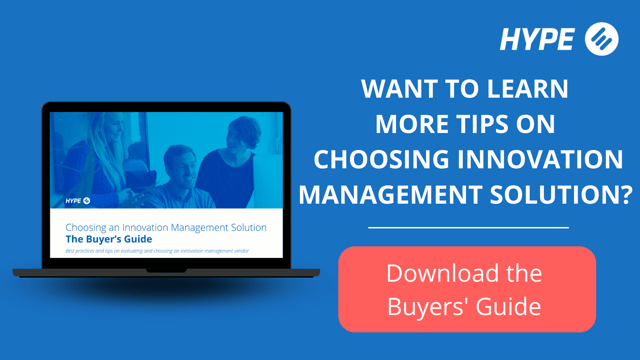Best practices and tips on evaluating and choosing innovation management software.
Innovation means change – change in the way we work, the products we make, the services we offer, the customer experiences we create, and the business models that fuel future growth.
In today's globally connected world, the forces that facilitate change – people, processes, technology – are moving at lightning speed. Product development times for many organizations are now defined in months (and sometimes days). And the biggest companies no longer have the loudest voices.
Innovative, communications-savvy companies can surface new ideas from inside or outside their organization, quickly test and validate concepts, and bring them to market quicker than ever before.
Today, the question for many organizations – whether you work for a startup, family business, enterprise, municipality, hospital, or university – is:
How can we effectively foster a culture of collaboration and innovation to harness great insights and ideas from inside and outside of our organization and turn them into game-changing products, services, and solutions?
What role does technology play in innovation management?
Innovation management is the process of driving ideas from a concept all the way through to value creation.
Technology is a critical enabler in managing a successful, scalable innovation program. Many organizations start simple and small – initially using spreadsheets, shared drives, and a mix of platforms to collect ideas and manage innovation projects. However, most innovation professionals realize the limitations of this approach. Lack of transparency, difficulty in managing volumes of input, and security challenges (especially in receiving and processing insights from external parties) are among the main obstacles.
In recent years, innovation management software has evolved to become adaptable and affordable for many businesses. As a result, the software industry has exploded with a myriad of solutions and technology platforms.

How to choose innovation management software
Organizations using software applications to identify and develop new ideas, as well as uncover a broader range of views, insights, and knowledge for their innovation programs should consider the following key questions:
- How will software help support our innovation process?
- What actions are needed to ensure the software is used correctly and delivers value?
- How can we ensure the technology we chose is scalable and multi-purpose to support a variety of needs today and be sustainable for future growth?
Having a software platform that offers the functions you need is vital in order to maximize the performance of your innovation program. And of course, the success of your innovation efforts depends on how you set the stage for innovation:
- Do you have a clear view of your innovation goals and strategic objectives?
- Have you defined your strategic innovation areas?
- Have you specified ownership and governance of your innovation portfolio?
The key success factors for managing innovation at scale are similar for small and large organizations. For both, it’s equally important to consider which technology provider will deliver the most value, not only with the software itself but also in supporting your organization’s culture and process of engaging employees, suppliers, and partners in your innovation program.
As we explore below, companies with well-developed sustainable online innovation programs typically consider the following five aspects when evaluating their options and selecting a software vendor: strategic alignment, people, process, technology, and community.
Here are the top 10 key criteria to consider in your evaluation of the right software. Does the platform you are considering do the following:
- Enable your organization to make innovation repeatable at scale
- Handle large amounts of diverse inputs and ideas
- Stimulate the exchange and capture of in-house knowledge and expertise
- Offer transparency to everyone involved about the process and actions taken
- Allow input from contributors inside and outside your organization in a manner that’s both secure and controllable
- Enable collaboration and idea management in a secure environment
- Provide structure and support in a defined process for front- and back-end innovation
- Provide good value for money and be affordable for both large and small organizations
- Integrate with other systems – like SharePoint, Yammer, Jive, ERP, PPM, ECM
- Provide flexible options for use – e.g., out-of-the-box solutions or customizable for your specific needs.
5 key aspects of selecting an innovation management solution
1. Strategic Alignment
A myriad of educational programs, literature, playbooks, guidelines, and other thought leadership are available for innovation professionals to help them as they develop and implement a strategy that’s unique to their organization and suitable for their needs. In this section, we don’t recommend a specific strategy or innovation model. Instead, we advise on the importance for innovation teams to gain strategic alignment throughout their organization, irrespective of which innovation model or practice they choose.
Launching an innovation management program might seem like a straightforward task – deploy a tool to collect ideas, ask employees to submit them, vote, and comment, and you’re well on your way to fostering a new culture of innovation.
In reality, those who have been through the process know it’s a different proposition. To realize tangible benefits that positively impact your business and facilitate a culture of innovation, you’ll need to consider and work through a wide range of issues. Depending on your organization’s culture, some of those will be straightforward, and some will be more challenging.
In particular, you’ll need to:
- Align your idea-generation activities with the goals of your business and the specific needs of executives
- Bring executives on board as sponsors, and educate and train them
- Ensure middle management is working toward the same innovation goals
- Develop a roadmap that offers a pragmatic journey of change, demonstrates business value quickly, and supports the longer-term ambitions of the company
- Create a framework for engaging with external contributors, including legal and IP functions
- Build a communications plan that generates excitement and creates credibility
- Define idea evaluation and decision-making processes and guidelines
- Work with sponsors to ensure successful ideas are taken through to implementation phases, and close the feedback loop for transparency on the full lifecycle of an idea
- Define your governance and reporting in the short, medium, and long term
And this is just at the macro level of your program. At the micro level, you’ll have additional steps to work through for every idea campaign, to integrate the specific needs of the individuals involved. If you want your program to grow and be self-sustaining, you’ll also need to consider how these aspects can be managed effectively without you or your team's direct involvement.
Given the number of challenges and opportunities, it can become easy to be distracted and not stay aligned with a strategy. This is where the Collaborative Innovation Canvas comes in. It’s designed to help innovation teams focus on the key aspects of their program – both at the macro and the micro level – and to continuously assess the health of the program.
”We positioned HYPE as the tool where we could apply performance metrics, surface critical data, and provide real-time dashboards to the executive team. This really sold the platform to the business, and HYPE has since become our tool of choice for our corporate margin improvement program.”
- Joe Ramos, Continuous Improvement Lead - ConocoPhillips
2. People
Organizations need to master techniques for effective collaboration across divisional boundaries, geographic locations, and beyond the organization itself. These techniques for collaboration allow them to:
- Find different ideas and insights from diverse or large groups of people
- Encourage collaboration to build and improve upon those ideas and insights
- Use a combination of community opinion and expert knowledge to assess the ideas and comments
- Use the content to act on business opportunities and problems
Although it might be stating the obvious, it’s worth highlighting that people are core to and the center of your innovation program. They carry the seeds of new products and business models and are therefore the greatest asset of your innovation program. When it comes to the innovation crowd, there are three groups of people you need to take care of: idea contributors, the innovation team, and campaign sponsors/stakeholders.

Idea contributors
Getting people to contribute ideas and share knowledge on a regular basis is a challenge. You can meet this challenge by creating a culture of innovation. But how do you accomplish this change, especially considering that innovation is often not on the priority list – particularly when factoring in limited budgets and resources?
The key is to deliver a seamless and engaging experience for the crowd. To create a compelling innovation atmosphere, you need to inspire your audience and make them believe that they are participating in something great – in a program that changes the company. That’s not easy.
Well-designed software can help to address these needs. Advanced innovation management platforms go beyond simple facilitation of idea collection, by providing features that support idea generation and overall innovation programs. For example, they offer:
- A strong user experience, with intuitive structure and functionality, following the latest developments in design
- Real-time insights to drive inspiration and bring focus and context to idea generation
- Brainstorming sessions for inspiring the production of new insights
- In-platform collaboration to jointly submit and develop ideas
- Early-stage evaluations and feedback sessions to involve your contributors in the review process and leverage the crowd’s knowledge
Above all, the technology should empower and support idea contributors rather than be a demotivating administrative burden.
The innovation team
The performance of your innovation initiative depends on your innovation team and their ability to manage the innovation process and platform. To best support them, you need to look beyond software as the single solution to the challenge. Instead, choose a vendor that provides ongoing support and offers:
- Coaching and training to successfully manage the innovation platform
- Knowledge, tactics, and best practice advice about how to engage and support the crowd
- Access to a network of peers to exchange best practices with other innovation professionals
- Opportunities for continuous education, such as forums, webinars, blogs, white papers
Campaign sponsors
Campaign sponsors – together with management stakeholders – are key individuals involved in supporting your organization's program and innovation in general. An innovation platform can struggle to gain sustainable traction if senior stakeholders and campaign sponsors are not fully supportive and engaged in the process.
Campaign sponsor involvement is critical – and is particularly effective if the sponsor of a campaign or online challenge is a senior manager or member of your company's leadership team. Bringing them into the process at the start is crucial, as is keeping them engaged during audience participation and in final idea selection and communication.
This is a reciprocal process for sponsors and stakeholders; your platform needs to have the capabilities to highlight relevant information easily, provide a secure and trusted channel for communication, and create on-demand reports with actionable and meaningful data.
Fujitsu's Active8 innovation platform is an excellent example of how this ecosystem works in practice. Active8 is the official corporate site for customer-focused collaboration and is accessible to Fujitsu's 156,000 employees worldwide. In addition, the innovation team has opened the platform for external ideation; idea communities include suppliers, customers, partners, universities, industry advisors, and technology experts. Active8 also integrates with Salesforce, Fujitsu's companywide CRM. All Activ8 innovation projects are tagged to the relevant CRM account and included in account reporting. This includes financial numbers related to innovation.
”Active8 shows how our customers absolutely expect us to be innovating with them. As a minimum, we have strengthened the customer relationship. And, we can also say that this was one of our differentiators in winning work. Innovation is now ingrained into the fabric of how we do business. The investment in the HYPE software as a platform for our innovation projects paid for itself ten times over in the first year of use alone.”
- Joachim Box, Director of Innovation - Fujitsu
3. Process
The innovation process is the backbone of your innovation initiatives. It’s the framework for translating ideas into actionable concepts and executable business cases.
Most organizations follow a two-phase innovation process, comprised of:
- Strategic setup and ideation, where idea discovery, collaboration, and generation take place
- Business case and value creation, where ideas are refined and developed toward implementation
If you’re engaged in large-scale ideation and innovation, you need a structured platform and process to convert ideas into revenue-generating, cost-reducing, and/or business-impacting initiatives (products, services, improvements, etc.).
Depending on the innovation objectives, either phase may be sufficient on its own. However, in combination, they offer cumulative value. For instance, sourcing ideas on cost reduction can provide quick wins through the front-end process.
As your innovation ambitions grow and your innovation program matures, you’ll need a process that brings more disruptive value by joining together the front end and back end of innovation. "Big" ideas, like disruptive products and new business models, need more detailed analysis, concept management, and implementation.
On top of this “end-to-end” capability, the innovation process should:
- Be based on practical experience with real innovation projects and be continuously optimized
- Provide transparency on the transition of ideas throughout the innovation funnel
- Include effective monitoring of the development of ideas through real-time reports
- Include tailored KPIs and idea-assessment workflows that meet the organizational requirements.
4. Technology
Strategy, people, and process need to be backed by a reliable, state-of-the-art software platform. It’s important that it allows for both rigor and flexibility. Rigor means you have clearly defined process phases, responsibilities, and measures. You want to encourage idea sharing and discover the best ideas early on. You also need to move ideas quickly from diamonds in the rough toward results that align with your corporate strategy.
However, your innovation process also needs to be flexible. For example, depending on the challenge you need to solve, you need to be able to adapt your audience and apply the right evaluation tools.
When assessing innovation management solutions, consider the following factors:
- Is the solution scalable?
When organizations start building innovation programs, they often operate locally and on a small scale, only including employees as participants. But as innovation programs scale up, so does their reach – expanding to other locations as well as customers, suppliers, and partners.
To ensure long-term innovation success, innovation management software should be able to scale accordingly and be able to:
- Handle a growing number of participants
- Handle large amounts of inputs
- Simultaneously host multiple campaigns of various scale and focus
- Support complex networks of internal and external participants securely and in a straightforward way
- Can you brand and connect the software with collaboration tools your organization is already using?
The success of an innovation management solution depends on the degree of adoption and engagement; if it’s not being used, it won’t yield any results. And, as people are usually set in their ways, introducing yet “another” tool may be challenging if it’s done the right tool introduced in the right way.
To make the adoption process as seamless as possible:
- Enable integration with collaboration and communication tools that your company is already using (SharePoint, Jammer, Jive, IBM Connections, etc.), to benefit from already developed channels where the engagement is high
- Offer a user interface in line with your organization’s branding to provide a more familiar user experience
- Does the software provide the right level of security?
Your innovation data gives you a competitive advantage. You might even look at potential new patents among your submitted ideas. Your vendor should offer secure authorization functionality, like SAML, and compatibility with IBM WebSEAL. Ideally, it should provide trusted certifications.
As your innovation program matures and your innovation crowd expands inside and outside your organization, your software platform should be able to respond to several types of access scenarios:
- Exclusive campaigns: Does the platform support campaigns with only a select group of participants?
- Idea confidentiality: Who can see what? Can you make confidential ideas “invisible” to selected participants in the campaign (and platform)?
- Support separate communities: Can you innovate with different groups independently from each other?
- Open innovation: Can the platform ensure the secure involvement of external contributors – customers, suppliers, and partners?
- Can you integrate the software with business systems like CRM, PPM, and ERP platforms?
The relevance of an innovation management solution increases significantly when the software can integrate with business-critical or back-office systems. Data residing in "information silos" is data unseen by other systems (aka "dark data").
Innovation software platforms can collect a myriad of data, such as customer or user preferences, product specifications, location, and time-dependent data. Sharing this data with other business systems can deliver rich analytic capabilities, enabling key stakeholders to derive better insights or make more informed decisions. Your innovation management solution should be able to integrate with the business platforms where your client, product, or financial data resides.
For example:
- Connecting your innovation and CRM platforms (like Salesforce or Microsoft Dynamics) enables users to register and track open innovation activities with customers or partners. Sales teams can track the value created from open innovation initiatives with current customers and partners or win new business by proposing collaborative solutions.
- Integrating product data in your PPM platform by aligning, concepting, and prototyping activities with the relevant product portfolio provides better product insights and enhances decision-making. It also saves money and increases efficiencies by surfacing potential product improvements or highlighting potential redundancies.

5. Community
Innovation management programs are more than just a software platform, and it takes more than plugging in a tool to generate the ideas your organization needs. It’s hard to overstate the importance of engaging with industry peers and colleagues for guidance and exchange.
Many innovation managers reference regular community engagement as a key to their success. This is especially true for small teams (or, for some innovation managers, a "team of one"). So, when comparing vendors, it’s well worth exploring their community of customers, innovation experts, and technology, education, and content partners.
During your due diligence, assess whether the vendor has:
- A broad portfolio of clients with different sizes and types of innovation communities
- Experience with clients from a wide range of industries
- Endorsements from third-party research firms (e.g., Forrester and Gartner)
- Expertise in working across geographic regions, multiple languages, and cultures
- A vibrant community of innovation professionals, enthusiasts, and experts
Using your software platform, you should be able to easily find references, resources, and tools to support your innovation program in general as well as expert guidance in specific areas of the ideation process. As you’ll be working closely with the vendor’s team, it’s worth exploring their innovation community in as much detail as time and resources allow. After all, the platform will guide innovation within your organization for years to come. So before you select a vendor for your innovation management program, try to:
- Interview several current customers (we’ve included a list of suggested questions in an appendix to our guide)
- Engage in an online forum discussion – or at least read a few articles from their blog
- Listen to a podcast or webinar
- Attend a user group meeting or forum (the best way to get a feeling for whether a vendor is a good fit)
”HYPE is more than just a product sold, they're like a close colleague. I’ve never had a question, challenge or concern that I’ve brought to HYPE that I didn’t walk away feeling that they provided me with the right tips and tools for my own innovation program, and therefore my own success. It’s a unique partnership that I truly value."
- Sarah Kelly, Innovation Program Manager - Liberty Global
Final Thoughts
Working with an experienced innovation management partner is an essential component of innovation success because they can:
- Provide robust, proven technology
- Bring together innovation industry and process consultancy expertise to support your program
- Engage with your company both individually and as part of a vibrant innovation community
As highlighted in this buyer's guide, leveraging robust technology to support your innovation program enables you to:
- Manage an innovation portfolio with governance and rigor
- Ensure effective innovation resource management so that the best ideas make it to market
- Integrate your innovation process with other information systems to ensure alignment
- Report on key metrics, communicate results, and celebrate success.




.jpg?width=558&height=372&name=scott-graham-5fNmWej4tAA-unsplash%20(1).jpg)





